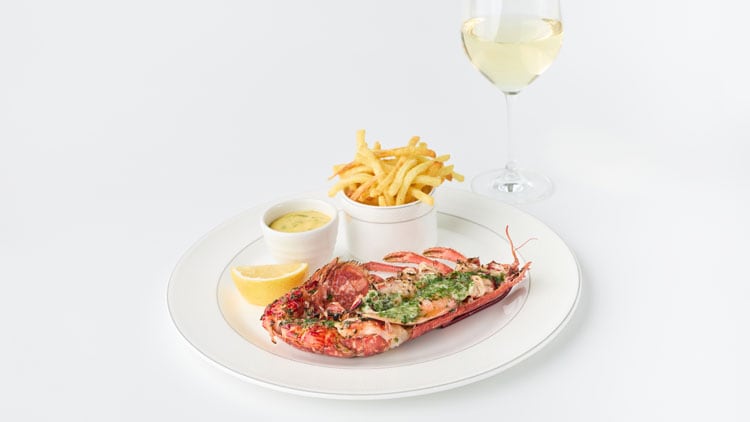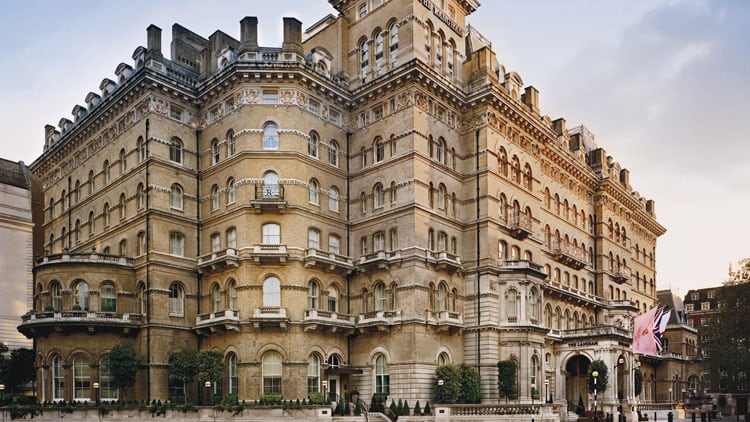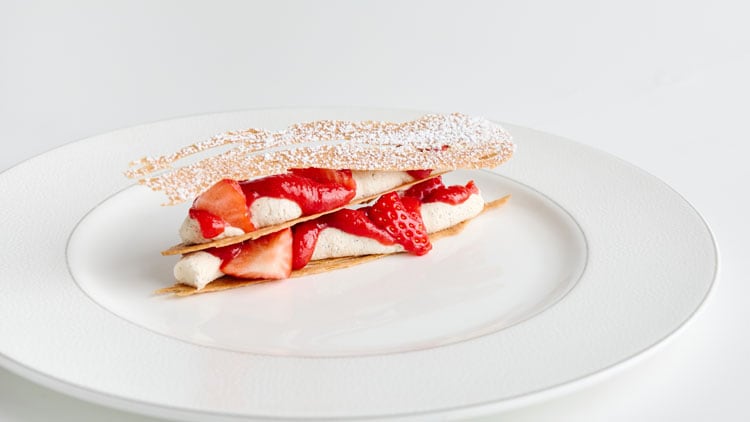Michel Roux is looking relaxed. Out of chef whites and leaning back in a chair in a meeting room at The Langham hotel, glasses propped up on his head, he cuts a figure of a man that has had a great weight taken off his shoulders. Three months earlier Roux called time on Le Gavroche, the French restaurant that had run for 57 years, first under the stewardship of his father Albert and uncle Michel, and from 1991 under his own leadership. It marked the end of an era in London’s culinary history, but also closed the chapter on what seemed to have become a labour of love.
“Every now and then I have moments of reflection on Le Gavroche,” says Roux as he recalls his 30 plus year tenure there. “Those were really tough and long days and weeks. I was doing 80-90 hours a week sometimes and I think ‘god, did I really go through all that?’. I can’t say I absolutely loved every moment but it’s something I would do again. I’m glad I came to a decision to close and move on. I can sit comfortably with that.”
You would, then, forgive Roux for taking some time out to smell the roses given the demands of running one of the capital’s most influential restaurants for more than three decades (as well as numerous other projects), but we are not here to chat about him slowing down. Instead, we are discussing the chef restaurateur’s latest project, the opening later this month of Chez Roux at The Langham hotel, adding to his portfolio of venues that includes high-end pub The Wigmore, also at The Langham, and restaurants in Scotland at Inverlochy Castle and Crossbasket Castle.

A taste of childhood
With Chez Roux, Roux is channelling his childhood memories, and while for many people this might mean creating a menu of spaghetti bolognese and breaded chicken and chips, his foodie upbringing had a little more depth to it.
Growing up in rural Kent in the 1960s, Roux was brought up at the Fairlawne estate where his father worked as a private chef for the Cazalet family. Somewhat fittingly, his mother went into labour one day when serving dinner to the family (he can’t recall what was on the menu that night).
“I very nearly popped up in the middle of service,” he laughs. “My mum was rushed to hospital, and I was back home the next day. I have been in a professional kitchen literally from day one.”
While his father was producing haute cuisine for the family upstairs this isn’t specifically the food of Roux’s childhood. He recalls being brought up “good hearty British food” such as steamed puddings, trifles, Manchester puddings and Welsh rarebits.
“I watched dad cook some great dishes, but when they were busy, I would be fobbed off to Mrs Bradbrook, the wife of the head butler, and she always used to feed me puddings with Bird's Custard. It’s these dishes we will be using as the inspiration at Chez Roux,” he says.
Chez Roux – which certainly won’t be serving Bird's custard – will also serve dishes on the first menus from Le Gavroche in 1967. The chef is currently going through the archives of typewritten recipes to decide which ones will eventually make the cut. They will include lamb chops reform, inspired by Alexis Soyer’s classic 1830s recipe, comprising herb-crusted lamb, faggot and reform sauce; and grilled lobster with garlic butter, fries and béarnaise (pictured), which he describes as one of his ‘death row’ dishes.

Chez Roux, then, will be a combination of classic haute cuisine and the more relaxed and rustic bistro style of French food currently impressing in London at the likes of Henry Harris’ Bouchon Racine, and Claude Bosi’s Josephine Bouchon. Roux acknowledges the popularity of these places but believes that by also bringing British dishes into the mix, Chez Roux is offering something different.
“Bouchon Racine and Josephine are very hard-core French, they have done extremely well. They are cooking better food than a lot of places in France and it’s incredibly honest, simple fare that doesn’t need embellishment or decoration, which is what we will be doing here. The difference is that Chez Roux won’t be brasserie dishes; we’re not serving boudin noir aux pommes, and there will also be some great British classics.
“One thing running Le Gavroche showed me is that people genuinely enjoy sitting down to a real plate of food, without any gimmicks. There’s far more satisfaction for a diner that sits down to a plate of food like that, with no frivolities and which you don’t have to scratch your head and look at it from different angles to figure out what it is or what the chef is trying to achieve. There will be no tweezers or micro herbs at Chez Roux.
“That’s the way we were going at Le Gavroche over the past few years - really simplifying everything and concentrating on great technique and great ingredients.”
Heading up the kitchen will be Dirk Schmittbeutner with Berwyn Davies executive chef of the hotel but Roux says he will also draft in Rachel Humphrey, Le Gavroche’s long-standing executive chef who is currently working at the events arm of the business, while the restaurant beds in.

A hotel relationship
Embarking on a new restaurant project so soon after closing one might seem rash, but Roux Jr’s long-standing relationship with The Langham meant it was something of a foregone conclusion.
He has been chef consultant at the Marylebone hotel for the past 12 years and previously ran Roux at the Landau restaurant, that he launched with his late father in 2010 (the site is now home to Provencal restaurant Mimosa) and also oversees bar-cum-pub The Wigmore at the hotel that opened in 2017.
Moreover, he already oversees the food offer at the Palm Court, the space that will become Chez Roux, which includes breakfast and afternoon tea, and the in room dining service.
“I love working for The Langham, it is a great group that has the same philosophy and goals as the Roux family, so why not continue working with them?,” he says.
“The Langham was keen to keep me here and I’m equally keen to stay.”
One challenge Roux has had to face at The Langham is to ensure Chez Roux is significantly different from Mimosa, the French Riviera-inspired restaurant also in the hotel. Roux dismisses the suggestion that it is unusual for a London hotel to house two different French restaurants and says he has been careful not to replicate or mirror what Mimosa is doing.
“Chez Roux is definitely not going to clash [with Mimosa] or cause any confusion. The Palm Court was previously the place where guests would come in and enjoy hotel food as it were - grilled steak, fish, salad, a burger so wanted to make something a bit more personal while making sure it’s a very different offer to Mimosa. In house guests need to have that choice between the restaurants and we need to attract outside guests.”
In total the space will do around 60 to 80 covers and much of the existing interior design will remain to ensure that it is suited to breakfast and afternoon tea rather. New paintings have been ordered but it won’t scream French restaurant.
“Palm Court is almost like a lounge, it’s comfy grandeur. My childhood was spent in a private house so it’s a space I’m comfortable with. The room is perfect for this particular concept.”
Roux is no stranger to working with hotels. Other restaurants in his portfolio include Seasgair at Inverlochy Castle, which opened in 2022, and Crossbasket Castle, on the outskirts of Glasgow, which launched in 2016. The Scottish restaurants are overseen by executive head chef Paul Tamburrini, who has worked with Martin Wishart who himself trained under Roux. “It’s great, because he knows my style of cooking,” Roux says.
At Crossbasket Castle he will in August open a second restaurant and live music and entertainment venue called Trocodero’s following a £15m investment at the property.
Trocodero’s is described by the chef as being “in a similar vein to Quaglino’s in its heyday” with a food offer that will be “easy going nothing too complicated”. The menu will be ultra seasonal and local, underpinned by French techniques.
As a chef who isn’t a stranger to restaurant closures - his Westminster-based restaurant Roux at Parliament Square closed in 2020 after failing to recover fully from the pandemic - he acknowledges that the current restaurant sector is difficult. Forging relationships with hotels, which can remove some of the big set up costs and risk, seems a prudent path to take.
“It’s very tough at the moment. If you don’t get it right from day one or first week you could be in trouble,” he says. “It’s also still incredibly expensive - energy costs have gone down but they are still hideously expensive, landlords, rent, inflation. Hospitality has got tougher for sure.”

A wider business
With numerous irons in the fire, Roux is a canny operator that hasn’t just weathered the current tough hospitality environment but continues to thrive in it. Not content with running restaurants in London and Scotland he has carved out a strong TV career and an events business, also called Chez Roux, that operates at sporting events including with the Jockey Club at Cheltenham, Newmarket, and Epsom and at Wimbledon. He also runs cookery classes and a culinary consultancy alongside his daughter Emily.
He also continues to capitalise on the strong reputation of Le Gavroche. While the restaurant may be no more, its brand - and spirit - lives on.
New for this year is Le Gavroche at The Lawn at Wimbledon in partnership with hospitality events business Keith Prowse. The space will attempt to replicate the Mayfair restaurant with a glass wine wall frontage and original and historic artwork and artefacts from the restaurant, with diners also able to experience the Le Gavroche cheese trolley.
Le Gavroche at Sea, in partnership with cruise line Cunard, will also return with residencies throughout the year on its Queen Anne and Queen Mary 2 liners.
“I’ve kept the name and it’s still trading,” he says. “I can close the restaurant, but I can’t sell the name of the business, it would be like selling my right arm. It’s too personal.”
He describes such projects a “bit of fun” and says he has been approached to do residencies under the Le Gavroche name across the world, something which he appears open exploring. While his cooking continues to change, the Le Gavroche name is proving to be a handy shorthand for a style of haute cuisine that the chef can dip into for instant recognisability.
“Under the Le Gavroche brand that would be the style of food wherever I go. It has been open for 57 years and has followers from all over the world. People were flying in for their last soufflé before we closed. Being able to take it anywhere I want is great.”
What of the Upper Brook Street space itself? The building’s owner Grand Residence Club by Marriott is currently seeking a new tenant, with high-profile chefs and international entrants said to be in the running. Not all the loose ends have been tied up yet - Roux admits that he’s yet to clean out his locker - but they are just formalities.
“Closing Le Gavroche was a big, big step - especially mentally,” he says of the process. “I have lots of mixed emotions.”
Is there an emotional attachment? “Not really,” he says, once again leaning back in his relaxed manner. “I hope the landlord gets the right person in and makes a success out of it but it’s not my problem anymore.
“It’s a building, it’s a space. I don’t think you can be sentimental.”





